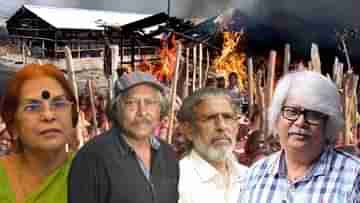News Desk, Kolkata : In the heart of Sandeshkhali, a storm brews as the enigma of Sheikh Shahjahan persists. Amidst this, a series of grave allegations echo through the pages of the national newspapers. For far too long, the women of this region, silenced by fear, are finally breaking their silence, unveiling a pattern of heinous abuses day after day.
As the Sandeshkhali incident reverberates through the political corridors of the entire state, and the people of Bengal rise in solidarity, the question arises: where do the intellectuals of the city stand in this tumultuous affair? Why, despite the harrowing accusations, are they not taking to the streets in protest? What are the thoughts of the intellectuals on the Sandeshkhali incident?
Renowned author Bani Basu has voiced strong condemnation, expressing her deep dismay. In a scathing critique, she asserts, “After hearing these stories, I have no desire to spare anyone. They have spawned so much anger, and yet, they have not burned in the fire of that anger. Their wrongdoing continues unabated. It’s a shame for us. I cannot fathom how such atrocities persist in a civilized society.”
Noted artist Samir Aich has also broken his silence, pointing fingers at the intellectuals of Kolkata. He remarks, “It’s regrettable to say, but Kolkata’s intellectuals have become shamelessly indifferent, succumbing to personal interests within the ruling party… It has severely damaged the essence of our movement. All their wrongdoings persist. It’s embarrassing for us. I never imagined such things would still continue in a civilized society.”
Veteran filmmaker Harnath Chakraborty, who has previously taken to the streets in protest, now questions the intellectuals’ stance on the Sandeshkhali incident. He states, “I cannot protest alone on the streets. We need to come together and move forward. We’ve done it before. I used to raise any protest through my films. The incidents in Sandeshkhali, the statements made by women, are truly distressing. It’s unacceptable.”
Theatrical director Rudraprasad Sengupta views the Sandeshkhali incident as a reflection of the entire state of Bengal. He communicates to the media, “The chaos in the whole of Bengal is depicted in Sandeshkhali.” He believes that the upheaval is not limited to personal disputes or factional conflicts but extends to every corner, be it within oneself or among different factions. Sandeshkhali, in his eyes, serves as a microcosm of the prevalent turmoil.
Sengupta further delves into the situation, stating, “When laziness, unemployment, and the need for money push one towards illicit activities, another factor comes into play—female companionship. If a little manipulation yields money, why wouldn’t women engage in it? Such a situation has emerged in Sandeshkhali, which is extremely unfortunate and shameful.”
As the narrative unfolds, the silence of the city’s intellectuals becomes an integral part of the story, raising questions about societal apathy, political entanglements, and the decay of moral fabric. The Sandeshkhali incident becomes not just an isolated event but a mirror reflecting the broader challenges faced by society.
In the face of these revelations, the intellectuals’ inaction becomes a point of criticism, prompting introspection and a call for collective action. The storyline captures the complexity of the socio-political landscape, urging a united front against injustice and raising a poignant question: Will the intellectuals break their silence and join the streets in protest, or will their inertia perpetuate the cycle of abuse and silence?
DISCLAIMER
Our news media denounces any form of bias and disapproves of sensationalism. The disseminated news is entirely educational and aimed at social awareness. Our media maintains absolute impartiality, adhering solely to the purpose of education and social consciousness.


